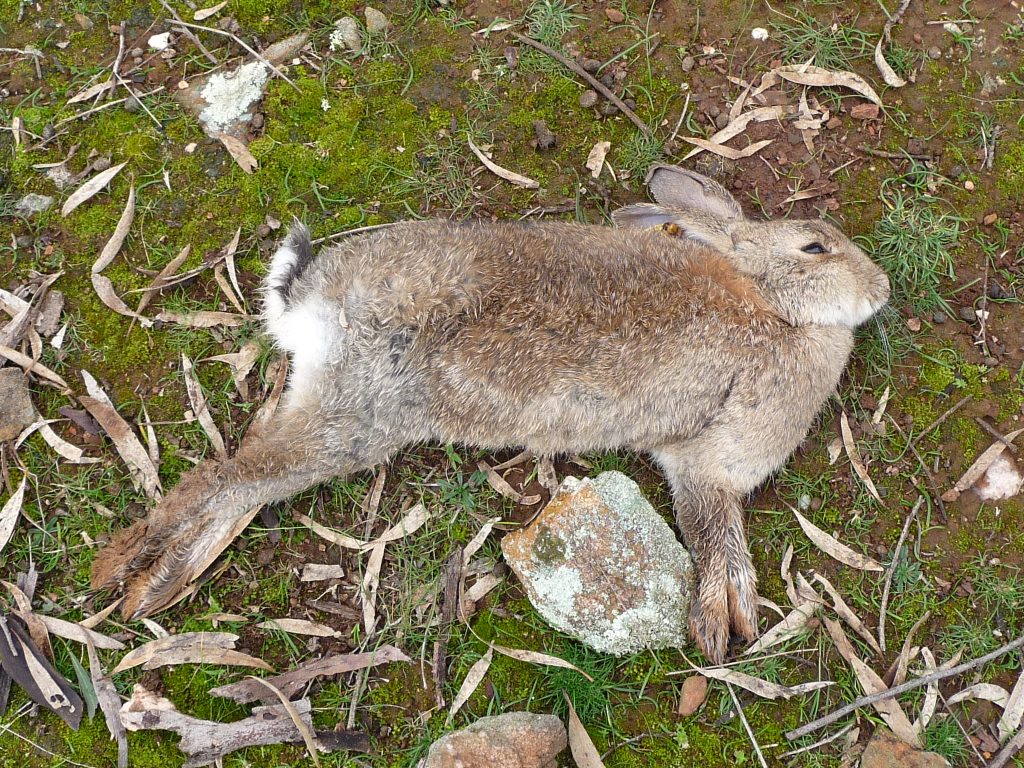By Greg Mutze, Biosecurity SA
About 6 years ago, two things happened that may ultimately lead to better biological control of rabbits in Australia.
RHD Boost (K5)
The first one was a plan developed by Australian rabbit researchers to look for new strains of rabbit haemorrhagic disease virus (RHDV, also known as RHDV1 or calicivirus) in Europe and Asia. It was known that some RHDV1 strains that that had been causing problems to rabbit meat producers overseas for 20 years were not present in Australia. The research program, called RHD Boost, introduced new strains of RHDV1 for testing at the Elizabeth Macarthur Agricultural Institute near Sydney. In particular, the research aimed to see if any of the overseas strains might be more effective in the higher rainfall areas of south-eastern Australia, where rabbits are partially protected from RHDV1 by a related, benign calicivirus called RCV-A1. RCV-A1 was present before RHDV1 was introduced but doesn’t cause noticeable disease. However, rabbits that have been infected by RCV-A1 are less likely to die when infected by RHDV1. A Korean RHDV1 strain (K5-RHDV1) was identified that killed a high proportion of rabbits with antibodies to RCV-A1 and it has been approved for release in autumn 2017. About 600 landholder groups have signed up to be part of the national release program. K5-RHDV1 may provide some benefit in the hot, dry areas where RCV-A1 is less common, but that is less certain.
RHDV2
At about the same time as RHD Boost research began, another new strain of calicivirus, RHDV2, emerged in Europe in 2010 and rapidly spread through France, Spain and Portugal. It was discovered in Canberra in May 2015. How it arrived in the country is unknown but it has also spread from Europe to pet rabbits Canada. The Australian strain is genetically similar to a strain from Portugal.
RHDV2 spread within 1 year to much of New South Wales and Victoria, probably aided by flies and mosquitoes, but possibly also through people moving infected pet rabbits, or contaminated equipment or food. It was detected in South Australia in December 2015, and spread gradually through almost all the agricultural districts and into the southern pastoral zone. Isolated cases have been reported from pet rabbits in Darwin and Alice Springs but it is not known to be widely established in wild rabbits in central Australia.
RHDV2 has been killing some pet rabbits that have been vaccinated against RHDV, and can overcome immunity in wild rabbits that have survived infection in previous RHDV1 outbreaks. In agricultural areas and areas of high biodiversity, it is hoped that the new strain might provide another significant knockdown of wild rabbit populations for some years. In France, Spain, Portugal and Scotland where RHDV1 has also been active 20-30 years, rabbit populations have been severely depleted by RHDV2 in the past 5 years.
Biosecurity SA Needs Your Dead Rabbits
Biosecurity SA expects that RHDV2 will continue to spread in arid Australia but want to discover how it competes with the existing field strains, and whether K5 RHDV1 Boost strain spreads naturally in those areas, or if there is an optimum time to make tactical releases of the K5 RHDV. The virus can only be identified reliably in the liver or bone marrow of rabbits that have recently died from the disease. Samples are urgently needed to monitor RHDV2 spread. Please call us if you see dead rabbits. Freeze them and we will organise the rest. Samples will help determine which strains are most effective, and at what time of year and where these strains are active.
More broadly, data from rabbit samples can be used to assess the effectiveness of the various rabbit biocontrols currently in existence and to argue for further research to find new biocontrols to benefit Australia’s agricultural industries and the environment.
In the event RHDV2 does take hold, it may significantly enhance the effectiveness of standard rabbit control measures, with less rabbits around to survive a control program and reinfest properties. This is a great opportunity to get long term control of persistent rabbit problems.
~ Greg Mutze
Download the LFW Rabbit Control Factsheet
How to Provide a Sample
Look out for dead rabbits that otherwise look healthy. This may be evidence of an RHDV1 or RHDV2 outbreak. Collect a rabbit carcass (or just liver, or long hind leg bones if the liver has been scavenged) and store it, with its source location and date, in a plastic bag in the freezer.
Record any observations. For example: “I used to count 50 rabbits driving from the gate to the house and in the last week I have seen none” or “I found a number of dead rabbits but there still seems to be heaps of live rabbits about”.
Once you have a rabbit sample in the freezer, please contact Biosecurity SA to arrange collection or drop-off of the sample for testing in Adelaide, or at CSIRO in Canberra.
Land managers will be advised of the results, which could confirm RHDV1 or RHDV2 activity in their area.
Further Information
Greg Mutze, Biosecurity SA, greg.mutze@sa.gov.au , 08 8303 9505
Dave Peacock, Biosecurity SA, david.peacock@sa.gov.au , 08 8303 9504
Category:
Ferals
